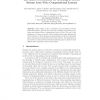Free Online Productivity Tools
i2Speak
i2Symbol
i2OCR
iTex2Img
iWeb2Print
iWeb2Shot
i2Type
iPdf2Split
iPdf2Merge
i2Bopomofo
i2Arabic
i2Style
i2Image
i2PDF
iLatex2Rtf
Sci2ools
IWINAC
2009
Springer
2009
Springer
Eye-Hand Coordination for Reaching in Dorsal Stream Area V6A: Computational Lessons
Data related to the coordination and modulation between visual information, gaze direction and arm reaching movements in primates are analyzed from a computational point of view. The goal of the analysis is to construct a model of the mechanisms that allow humans and other primates to build dynamical representations of their peripersonal space through active interaction with nearby objects. The application of the model to robotic systems will allow artificial agents to improve their skills in their exploration of the nearby space.
| Added | 27 May 2010 |
| Updated | 27 May 2010 |
| Type | Conference |
| Year | 2009 |
| Where | IWINAC |
| Authors | Eris Chinellato, Beata Grzyb, Nicoletta Marzocchi, Annalisa Bosco, Patrizia Fattori, Angel P. Del Pobil |
Comments (0)

